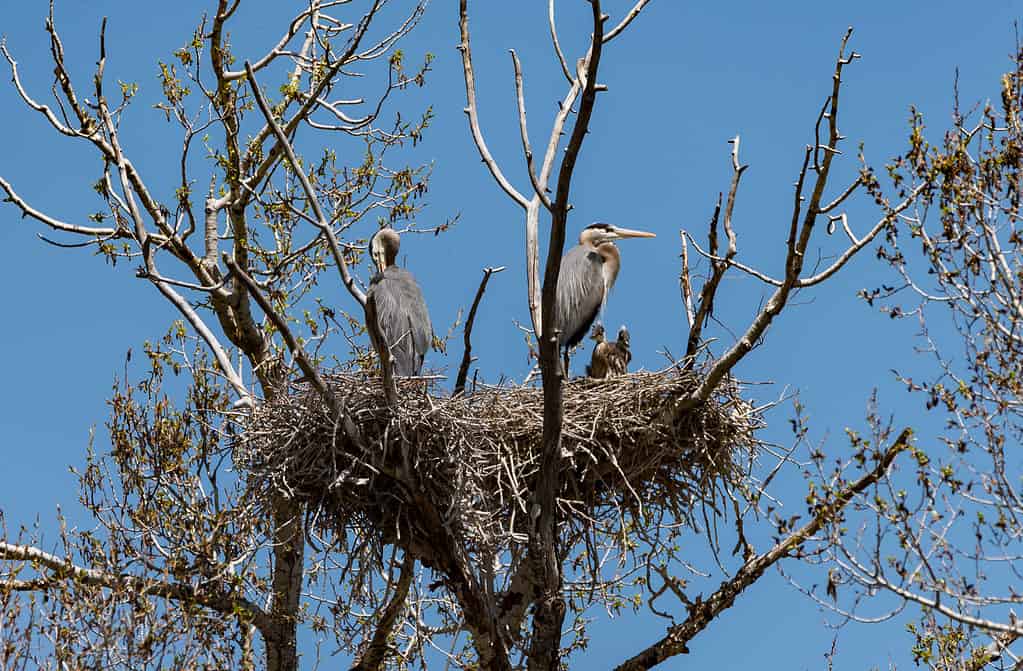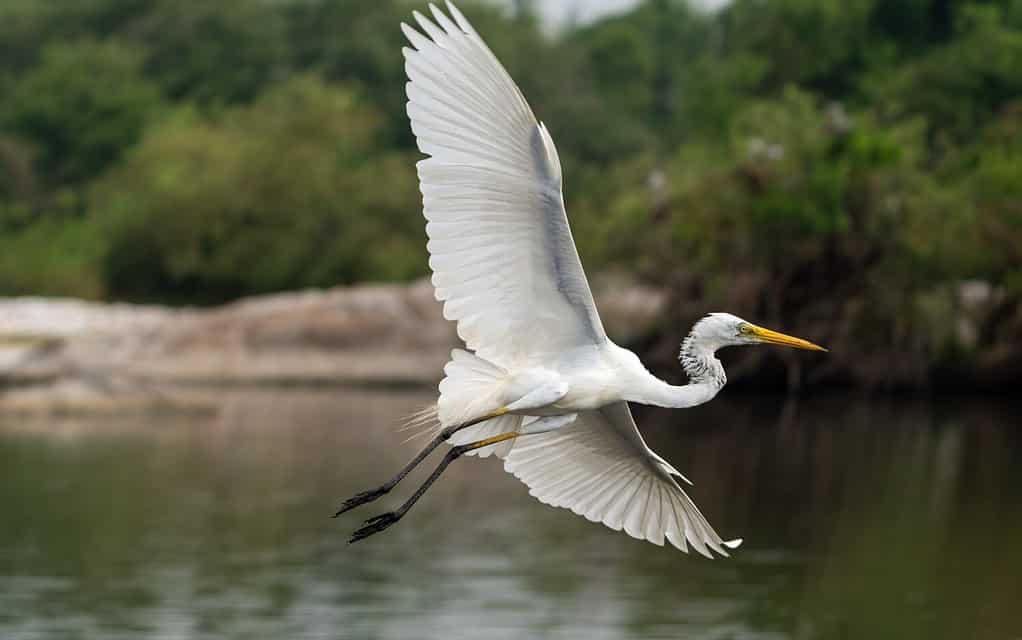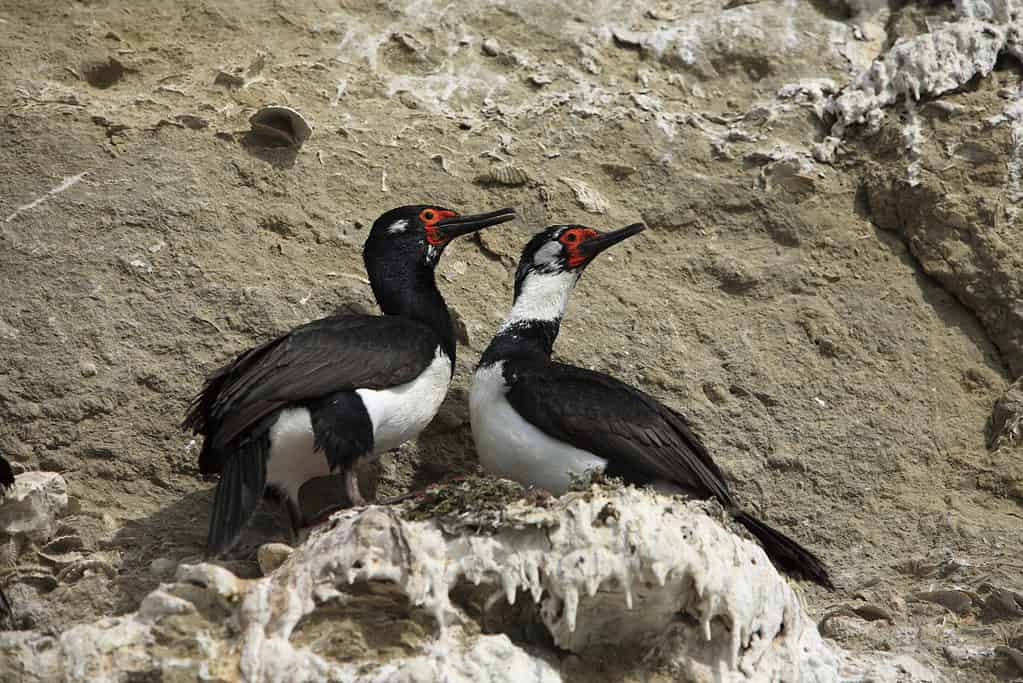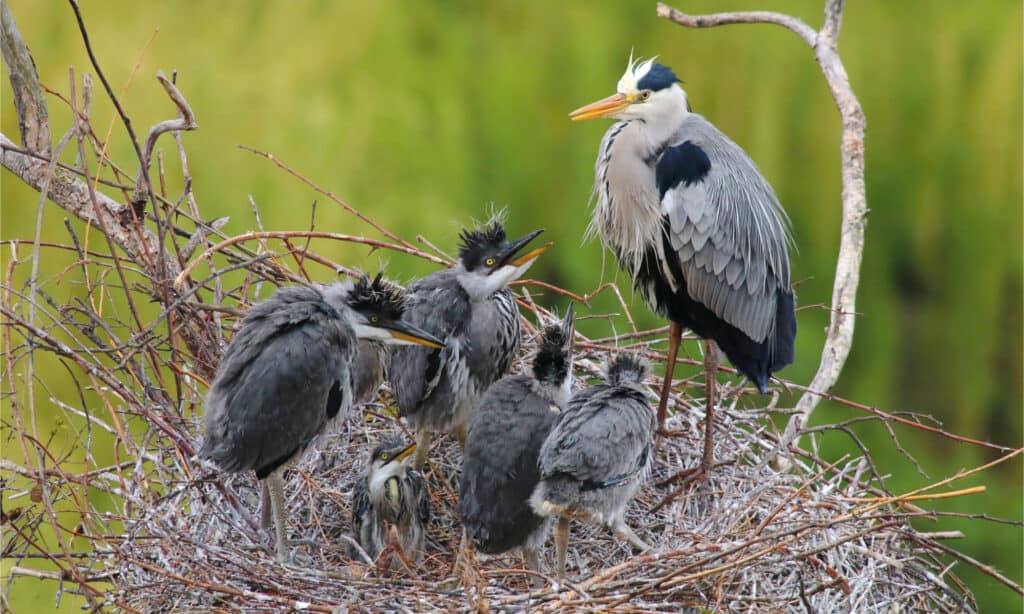The waters of the world offer the opportunity to see a wide variety of wildlife, including birds. While some species may only visit water for food or a quick drink, some species live their entire lives on or close to the water. This includes herons, egrets, and cormorants. Below, learn more about where herons, egrets, and cormorants nest, as well as more about each species!
Species and Nesting Behaviors: Herons

Herons often form large nests in trees, with others nesting nearby.
©mark smith nsb/Shutterstock.com
There are 72 recognized species of heron, all of which are categorized in the family Ardeidae. Known for their long legs and long necks, these birds can be found both in freshwater and marine habitats.
Because there are so many different species of heron, their nesting behaviors can differ greatly. A large portion of heron species will often form colonial nests, that is, nesting with a number of other members of the same or similar species. These nests are often in trees. However, other groups of herons, most notably those known as bitterns, will nest on the ground, in reed beds.
The gray heron (Ardea cinerea) will build its nest in tall trees, most often those 82 to 164 feet from the ground. However, this is not always the case. Gray herons may also make their nests on the ground or even on cliffs. The nest itself is a large stick platform that the herons will reuse and renovate each year.
The great blue heron (Ardea herodias) is similar in their nesting locations. However, along with tree and ground nests, these birds will also build their nests on man-made structures, including artificial platforms. This species does nest colonially, with some colonies having over 500 nests in an area.
Little blue herons (Egretta caerulea) will also nest colonially. However, they prefer to nest in shrubs or small trees compared to nesting at great heights.
Species and Nesting Behaviors: Egrets

Like herons, egrets often nest colonially in trees, although they may also take to the ground of man-made locations.
©Banu R/Shutterstock.com
Egrets are actually a type of heron. Most often, you will see the term egret refer to white or light-colored species in the family Ardeidae while darker specimens are referred to as herons. However, this is not a constant, such is the case with the great white heron.
Because they are related, egrets and herons often share many breeding and nesting behaviors. This includes choosing tree, ground, or artificial nesting locations (depending on the species) and mixed-species colonies.
However, when comparing egrets to herons, one behavior you will see more often is cooperation in nesting. While not true for all heron species, many have one member of the breeding pair choosing the nesting location and building the nest. In egrets, however, both parties often engage in not only choosing the nest location but in the construction.
Species and Nesting Behaviors: Cormorants

Many ocean-living species of cormorants will build their nests on cliffs.
©iStock.com/THIERRY EIDENWEIL
Whereas herons and egrets share many nesting behaviors because of their close relations, cormorants are much different. Cormorants are closely related to shags, with whom they make up the family Phalacrocoracidae. There are approximately 40 recognized species within this family. Cormorants are rather large seabirds. Some species may be found only in coastal waters, while others may venture inland. Because of this, nesting habitats may vary.
Overall, for pelagic species, nesting colonially on cliffs is common. This includes species such as the red-faced cormorant, the pelagic cormorant, and the great cormorant. However, because the great cormorant, along with other members of the family, may also be found further inland, even in the middle of some continents such as Africa, such cliffs aren’t always available. As a result, you may also find them nesting in trees or abandoned man-made structures.
What to Do If You See a Bird Nest

Watching a nest can be interesting, but it is important to it the right way for both your safety as well as the birds’.
©Miroslav Hlavko/Shutterstock.com
Seeing a bird nest can be an exciting time. This is especially true when it comes to seeing such large and active nests such as those of colonial species like herons and egrets. However, in order to keep both you and these amazing birds safe, it’s important to keep a few things in mind.
First, never approach a nest. More often than not, otherwise docile species of birds can become territorial and even aggressive during the breeding season. As a result, approaching the nest can be dangerous, leading to injuries such as bites. Studies have also shown that disturbing a nest, especially during the early stages of the nesting period, can have negative impacts on the birds. This can make it more difficult for species to thrive, especially when you’re dealing with threatened or endangered species.
While you shouldn’t approach or disturb a nest, you can still watch from afar, however. It can be exciting to watch a pair of birds build their nest, lay their eggs, and eventually raise their young. If you’re lucky, you’ll even be able to capture amazing moments such as an egret feeding its offspring, an event much easier to see in larger birds like those mentioned above compared to smaller songbirds.
The photo featured at the top of this post is © James W. Thompson/Shutterstock.com
Thank you for reading! Have some feedback for us? Contact the AZ Animals editorial team.






